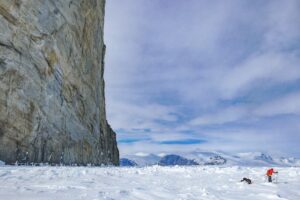Last month, veterans John Dunn and Graeme Magor completed perhaps the most imaginative arctic expedition of 2022 – a 58-day, 835km spring-summer ski traverse of the world’s third-largest uninhabited island, Axel Heiberg.
Dunn and Magor, two of the Canadian Arctic’s most experienced travelers, started out on April 29 from Sherwood Head (around 78˚N) on the southern coastline.
Heading north, Dunn and Magor made a beeline to the east to avoid the Steacie Ice Cap, which was also originally on their itinerary. “In the weeks leading up to the trip — partly for variety’s sake — we had switched the first part of the route away from the Steacie Ice Cap in favor of a series of valleys leading to Strand Fiord. This proved to be a good choice in light of our later travails on the Strand Glacier and ice cap,” reasoned Dunn.
By May 8, they had worked hard to tick off 90km, sometimes hauling all four sleds in a combined train to make lighter work of the steep passes and elevation gain.
“At the start, it was very hard work…I’d never hauled 60 days of food before. But we took our time, always hauled as a train, and slept like babies.”

Making camp in Wolf Valley. Photo: John Dunn/Arcticlight
Lost a week
After two weeks, Dunn and Magor hit their first stumbling block, blizzard conditions and fresh snowfall on the Strand Glacier. This relegated the duo to double shuffling their sleds to make progress. Dunn estimates that this slow section cost them a week of progress.
Eventually, off the Strand Glacier, the veterans reached the dry eastern side of Axel Heiberg, which provides better snow for sledding. Moving north of 80˚N, Ellesmere Island and Greely Fiord came into view some 90km away. They stashed one sled each under dirt on the east coast of Axel Heiberg on May 29 before trending inland again.

The completed route with start point at Sherwood Head and finish at Buchanan Lake. Image: John Dunn/Arcticlight
Despite being self-confessed pensioners, Dunn reports that the physical challenge of sled hauling day after day was still achievable. “Overall, our bodies held up really well. No issues we could not deal with.”
Still on schedule
The pair’s original intention was to reach the northern tip of Axel Heiberg by June 2. Their estimate was not that far off, as they arrived at Cape Stallworthy (81˚N) on June 7. Although pleased to have traversed the island, they were a long way from home, and anxious to ensure that foxes, wolves, or polar bears had not pilfered their cached supplies.

Graeme Magor and John Dunn at Cape Stallworthy. Photo: John Dunn/Arcticlight
To return south to their starting point in time for their chartered pickup, they had to make 22km per day for 21 days. With that in mind, they didn’t linger around the intriguing north coast but pressed on south immediately. They switched to night travel to keep the sun behind them and benefit from cooler temperatures and therefore firmer snow conditions. Along the way they came within 500m of a few polar bears, which were thankfully spooked by the duo’s scent. To save weight, and because of their largely inland route, they had chosen not to carry a firearm.
By June 14, Dunn and Magor had cranked out 175km southward and located their cache. However, shortly after this, they lost a day due to “uncrossable leads and very complex melt pools.” They decided that it would be too risky to press on with the opportunity for further delay along the coast. Instead, they decided to be picked up at Buchanan Lake on the east-central coast.

Graeme Magor crosses a small lead. Photo: John Dunn/Arcticlight
Slight shortfall
Between Buchanan Lake and Sherwood Head there are no known landing strips for aircraft. (It was too late in the season for a plane to land on the water-logged sea ice.) So after 58 days and roughly 835km, Dunn and Magor were picked up on June 26. In the end, they fell a couple of hundred kilometres short of a complete double traverse.
Not that this seems to have detracted from their experience, nor of Dunn’s appetite for future travel. “No chance in hell!” he said when asked if this was the end of his hard trekking in the High Arctic.

Sled lining on the eastern coast. Photo: John Dunn/Arcticlight






